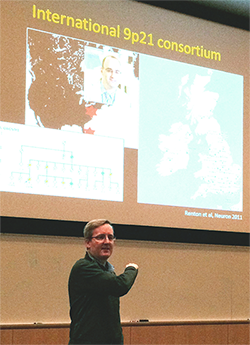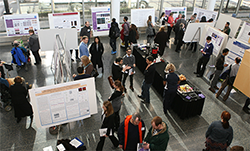
Researchers, experts, doctors and patients gathered at the Les Turner Symposium on ALS and NeuroRepair with a common goal in mind – to promote collaborative research in Amyotrophic lateral sclerosis (ALS) with the goal of finding new therapies and eventually, a cure.
The event – the fourth annual ALS symposium – featured data blitz sessions by many local ALS experts, a poster session and an “Ask the ALS Experts” panel for patients.
Hande Ozdinler, PhD, associate professor in the Ken and Ruth Davee Department of Neurology and organizer of the event, welcomed guests and explained the theme of this year’s symposium: “Neurons that fire together, wire together,” which she said emphasizes not only the need for neurons to fire together in our bodies but also the need for experts in the field to collaborate on research and sharing of data.
“As neuroscientists, we have to work together with our friends and partners to form functional collaborations and execute success,” she said. “We need more people who act as neurotransmitters, generating interest and creating hope for patients. We need more who can make a difference in people’s lives.”
Keynote speaker, Bryan Traynor, MD, PhD, senior investigator and chief of the Neuromuscular Disease Research section at the Laboratory of Neurogenetics at the National Institute on Aging, discussed current research initiatives and major ALS breakthroughs, including the identification of the C9ORF72 gene as the underlying mutation in a large portion of familial ALS cases.
“We know now the genetic etiology of two thirds of familial ALS and about 10 percent of sporadic ALS. Compared to what we knew just a few years ago, this is amazing, but we still have much more work to do,” Dr. Taynor said.
During his speech, Dr. Traynor emphasized the need for genome-wide association studies.
“Genetics is now a team sport,” he said. “Gone are the days of a lonely scientist sitting in his lab waiting for results; we have to be part diplomat in order to get these endeavors to work.”

The need for cooperation and coordination among scientists to find an effective treatment for ALS was a theme throughout the symposium.
“In our brain there is not a single neuron that functions in isolation,” Ozdinler said. All complex tasks, she explained, require synchronized and precise activation of many neurons, and degeneration of those neural circuits will result in disease. “If we want to build effective treatment strategies, we have to act like our brains and form functional circuitries among scientists.”
New Upper Motor Neuron Reporter Cell Line Available to All
That spirit of cooperation also motivated Ozdinler to make an important resource accessible to scientists everywhere. She and her lab recently developed the first reporter cell line to investigate upper motor neurons. Recent studies have identified these neurons, which extend from the brain to the spinal cord, as a new target for therapy against ALS.
“Special neuron populations are more vulnerable in neurodegenerative diseases,” she said. “It is important to identify these neuron populations to study the mechanisms that cause their vulnerability.”
The new reporter cell line, available to the public now, helps visualize specific neurons involved in motor neuron degeneration with a green fluorescent protein.
“Since ALS is a very complex disease, we need many different groups to focus on different aspects of the disease. The reporter line we generated will enable researchers all around the world to begin to study the biology of upper motor neurons with respect to disease,” Ozdinler said.
For that reason, she chose to make her innovation open to everyone instead of keeping it private.
“Science grows better when it is transparent and shared,” she said.






